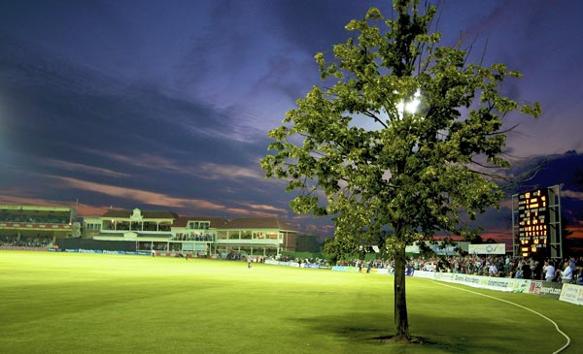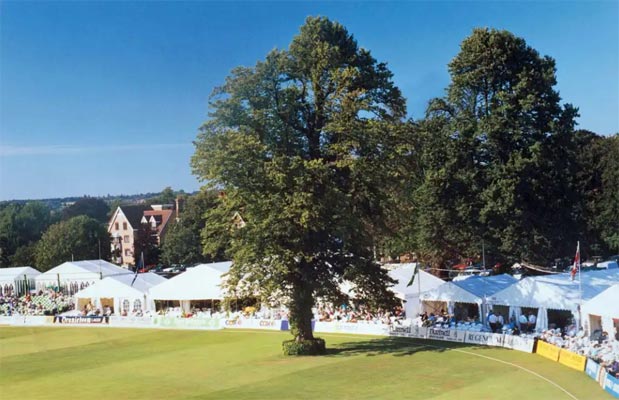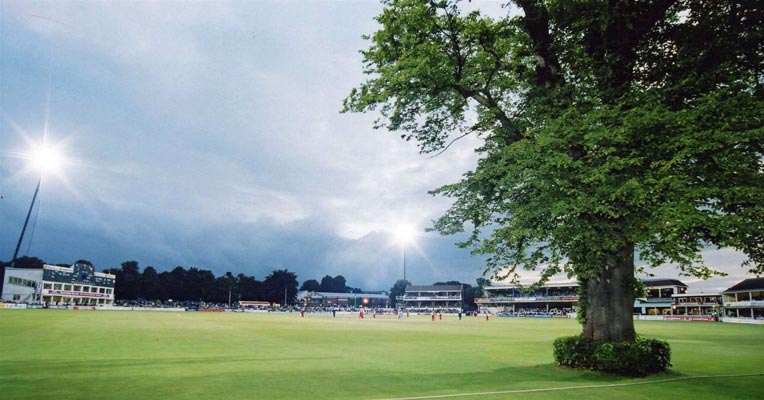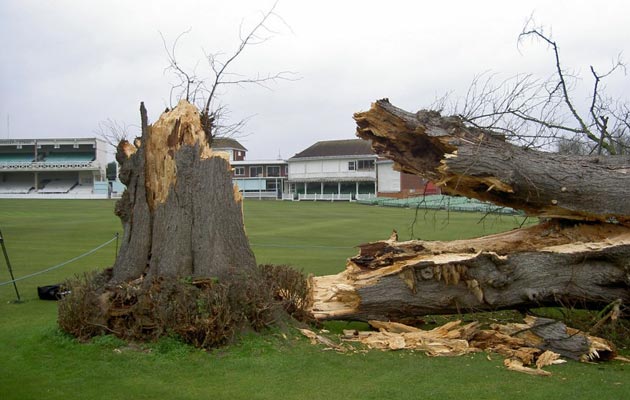THE FAMOUS LIME TREE
at The Spitfire Ground, Canterbury
This 'young' tree was planted as a Memorial to the legendary St Lawrence Lime Tree, which was felled during gale force winds on 9th January 2005.
The old tree was thought to be more than 180 years old and was the only tree in county cricket which sometimes stood within the playing area.
It became a challenge to batters to clear it. If successful, the shot was worth six runs. There is evidence of it being cleared on only four occasions.

The new Lime Tree was planted in 1999 and moved in 2005
-----

The Old Lime Tree in all its glory during Canterbury Cricket Week
-----

The Old Lime Tree inside the boundary during a match.
-----

The Old Lime Tree - felled by high winds in Jan 2005.
-----
OTHER LIME TREE RESOURCES
Wikipedia page.
New Tree Planted - BBC News.
CLEARING THE OLD LIME TREE (for a Six)
The famous Canterbury Lime Tree, which stood on the St Lawrence ground for at least 180 years, was blown down in a winter storm in January 2005. As most cricket lovers know, a hit to the tree counted four, but to hit a six, the batter had to clear the tree altogether. If the ball so much as flicked the topmost leaf of the tree as it sped out of the playing area and quite possibly out of the ground, it still only counted four.
So perhaps it is not too surprising that in the almost two centuries that the tree stood, there are only three indisputable cases of a batter in a professional match earning six runs by clearing the tree. When you consider that in the early years, very few games were played at Canterbury – no more than two or three a year – and that the tree would not have been within the playing area in many of those games, you can see how rarely the feat was recorded, let alone achieved. What’s more, until the early years of the last century, all boundary shots counted as four unless they went right out of the ground, so it’s impossible to tell from the scorebooks alone which shots might have had the power and elevation to fly over the lime tree, in all its 90 feet high glory.
The first definite record of this enormous hit came on 6 August 1925, when a little remembered amateur batter playing for Sussex against Kent, Arthur “Jacko” Watson, hit a vast six in Sussex’s first innings. Watson scored 53, including a massive hit off the bowling of Tich Freeman “right over the famous Lime Tree, some 30 yards over the President’s Tent and it ended up out of the ground”, as Gerald Brodribb described it in his book, Hit For Six. Actually it didn’t quite get out of the ground - it landed on a catering van, smashing crockery before bouncing and getting lost in the bushes at the edge of the Nackington Road. It was found during the winter when the ground staff were tidying the undergrowth and found a ball with bits of china embedded in it.
In 1928, when the West Indian tourists came to play at Canterbury on 25 August, the feat was repeated. This was the fourth first-class game at Canterbury that summer, only the third time that more than three games had been played there in a season, and in the West Indian team was one of their greatest ever cricketers, Learie Constantine. He only made 30, batting at number seven, but 28 of them were made in boundaries, including two sixes. The Times reported that “Constantine made one tremendously high on-drive which cleared the top of the Tree just in front of the Buffs enclosure, probably the biggest hit ever seen on the ground.” The record had been equalled.
The honour of Kent, who had conceded two tree clearances without managing one themselves, was restored by Carl Hooper on 11 May 1992. In his first home Championship match for Kent, he hit an astonishing 115 against Durham, in a fourth day attempt to get a result from a rain-affected game. His runs came in 89 balls, largely in a fourth wicket partnership of 197 with Neil Taylor. Hooper hit 13 fours and five sixes. According to the Kent Annual for 1993, “one of his sixes, off Simon Brown, cleared the famous lime tree, and it was said to be the first time this had happened since 1933.”
1933? I am hoping this was a typo, as there is no other evidence of any such big hit in 1933. There are two other more or less likely cases of a hit over the tree. Robert Relf of Sussex made 210* against Kent on 7 Aug 1907. The scorebook only recorded that he hit 33 fours, but in those days sixes had to go right out of the ground, so he may well have cleared the tree and only been given four for his efforts. Having top scored in the 1st innings with 67* at number eight, he was promoted to number three for the second innings and hit his first and biggest century, 210, as Sussex made 436-3. He shared a third wicket stand of 150 with the great C.B. Fry, who made only 37 not out. Many of Relf’s biggest hits were off the bowling of Ted Dillon, and there is a reasonable probability that one of these hits cleared the lime tree.
Our second ‘probable’ is C.I.J. ‘Big Jim’ Smith of Middlesex, who played against Kent in the second match of Canterbury Week in 1939. Big Jim (6 foot 3 and 17 stone), a ferocious fast bowler who played five Tests for England, scored 101 not out, his only first-class century. It contained five fours and seven sixes. As David Robertson says in his book on the Lime Tree, “three of his sixes cleared the tents and one landed on the roof of the pavilion, but despite much research, no firm evidence that any of his sixes cleared the tree has been uncovered.” Another report says that Smith managed a “hit over the trees at square leg”, but the Lime Tree would only have been at square leg for a left handed batter, and Big Jim batted right handed. I know that reverse sweeps were unthought of in 1939, but there is enough hearsay evidence to include this innings on the list of probables.
I was surprised to find that the tree was never reported to have been cleared during any limited over matches since the formation of the Gillette Cup and the Sunday leagues in the 1960s. But nobody has ever suggested that there were massive hits over the St Lawrence lime in any limited overs match, and now they will never happen again. The old Lime Tree is gone, and with it a rarely achieved target.
© Copyright Kent Cricket Heritage Trust